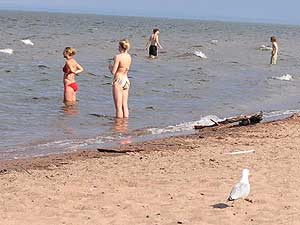|
Audio
Photos
Resources
Your Voice
|
What's happening to Duluth's beaches?
July 21, 2004
The Minnesota Pollution Control Agency has posted yet another beach in Duluth with a yellow warning sign. The water has high levels of bacteria, and the MPCA is advising people against swimming. Three other beaches were posted in recent weeks. It's the second summer of beach testing on Lake Superior. Scientists aren't sure yet what's causing the high bacteria levels, but they're beginning to narrow down the possibilities. It's the second summer of beach testing on Lake Superior. Scientists aren't sure yet what's causing the high bacteria levels, but they're beginning to narrow down the possibilities.
 | |||
Duluth, Minn. — Emily Beresford pulls on rubber hip waders and disposable plastic gloves that reach above her elbows. She's getting ready to collect water samples.
"You wade out to about knee-deep, and you dip the jar as deep as your elbows," she explains.
Beresford is a summer intern at the Minnesota Pollution Control Agency in Duluth. Every Monday she and other workers test 37 beaches from Duluth to the Canadian border.
Today isn't Monday. Beresford has come back to this spot nearly every day for more than a week. That's because the water here is contaminated with E. coli bacteria. Last year the bright yellow warning sign stayed up at this spot for most of the summer. It's likely to be there most of this summer too.
 | |||
This beach is on the harbor side of Park Point - the long strip of land that stretches into Lake Superior from downtown Duluth.
Heidi Bauman runs the beach monitoring program for the MPCA. She says the most serious problems show up on the harbor Park Point.
"We suspect they may be related to the shallow, dark, warm waters on that side of the Point," she says. "There are a lot more birds on that side, and there isn't as much wave action as there is on the lake side."
On the lake side, the water is clear and the sunlight kills bacteria quickly. Last year there were no warnings posted on the lake side of Park Point. The latest warning is posted at Leif Erikson park, just up the shore from Park Point. When the beach monitoring program began last year, Bauman and others were surprised at how many times they had to post the warning signs. And it's not just in Duluth. Early in July, shorelines near the Stewart River and the Split Rock River north of Two Harbors were posted.
 | |||
Bauman says that happened just after heavy rains, which probably washed animal droppings into the rivers and flushed them into the lake.
And last year a yellow sign went up at the harbor in tiny Grand Marais near the Canadian border.
"The harbor there has a lot of geese," she says, "and the day we had the advisory there big waves - six, seven, foot waves, churning up all the goose droppings sitting on bottom there."
Other postings have come when Duluth or Two Harbors had sewage overflows. There were a lot of those last summer, but Bauman says this year they haven't detected problems from sewage overflows.
The testing process takes some time. The lab runs the sample water through a filter and then incubates the organisms on the filter.
 | |||
"Between sampling, the incubation period, and then counting the colonies on these filters, it's a good 24-30 hours before we get actual numbers," Bauman says. "Of course that means that things could totally change by the time we post an advisory."
But Heidi Bauman says people can take common-sense precautions.
"I personally wouldn't swim the day after a big rain event, at least in an urban area," she says. "If there's a lot of geese or ducks floating around in an area all the time, I wouldn't swim in that location. In the case of Park Point I'd swim on the lake side, not the harbor side."
Most people do choose to swim on the lake side. But there are two boat clubs in the harbor, where people learn to kayak and sail. And kids living on Park Point like to swim on the bay side, which is usually warmer.
Chanae - who's 11 - heard about the advisories from her uncle.
"I heard they're really bad, and it's just from all the rain," she says. "So now I'm not allowed to go swimming over at the bay."
 | |||
Residents and visitors are calling the MPCA to ask where it's safe to swim.
Heidi Bauman says people need to realize that what they put on lawns and streets goes directly into the lake. And she says there are things we can do to help.
"Cleaning up after your dog, making sure your kids are wearing rubber pants when they go swimming in the lake, not feeding the geese so they maybe won't hang around here quite as much."
Scientists at the University of Minnesota are hoping to do DNA testing next year to try to pin down exactly where the bacteria are coming from.
|
News Headlines
|
Related Subjects
|

